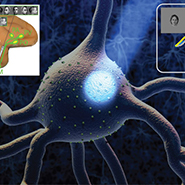The ability to extrapolate and make inferences from partial information is a central component of intelligence and manifests itself in all cognitive domains including language, vision, planning, and learning. This project aims to elucidate the computational mechanisms responsible for pattern completion by combining neurophysiological recordings, behavioral measurements and theoretical modeling. We focus on the problem of visual object completion, which is essential for the Center’s challenge of “What/Who is there?”. This effort is focusing on:
(i) characterizing the behavioral ability to perform visual object completion (including speed, dependence on amount and type of occluders, effects of masking),
(ii) interrogating the neural circuits along the ventral visual stream during object completion and
(iii) building a biologically plausible model that includes both bottom-up and recurrent connections and is capable of achieving human performance in object completion

 Abstract thinking and complex problem solving constitute paradigmatic examples of computation emerging from interconnected neuronal circuits. The biological hardware represents the output of millions of years of evolution leading to neuronal circuits that provide fast, efficient, and fault-tolerant solutions to complex problems. Progress toward a quantitative understanding of emergent intelligent computations in cortical circuits faces several empirical challenges (e.g., simultaneous recording and analysis of large ensembles of neurons and their interactions), and theoretical challenges (e.g., mathematical synthesis and modeling of the neuronal ensemble activity). Our team of theoreticians and neurophysiologists is focused on systematic, novel, and integrative approaches to deciphering the neuronal circuits underlying intelligence. Understanding neuronal circuits that implement solutions to complex challenges is an essential part of scientific reductionism, leading to insights useful for developing intelligent machines.
Abstract thinking and complex problem solving constitute paradigmatic examples of computation emerging from interconnected neuronal circuits. The biological hardware represents the output of millions of years of evolution leading to neuronal circuits that provide fast, efficient, and fault-tolerant solutions to complex problems. Progress toward a quantitative understanding of emergent intelligent computations in cortical circuits faces several empirical challenges (e.g., simultaneous recording and analysis of large ensembles of neurons and their interactions), and theoretical challenges (e.g., mathematical synthesis and modeling of the neuronal ensemble activity). Our team of theoreticians and neurophysiologists is focused on systematic, novel, and integrative approaches to deciphering the neuronal circuits underlying intelligence. Understanding neuronal circuits that implement solutions to complex challenges is an essential part of scientific reductionism, leading to insights useful for developing intelligent machines.